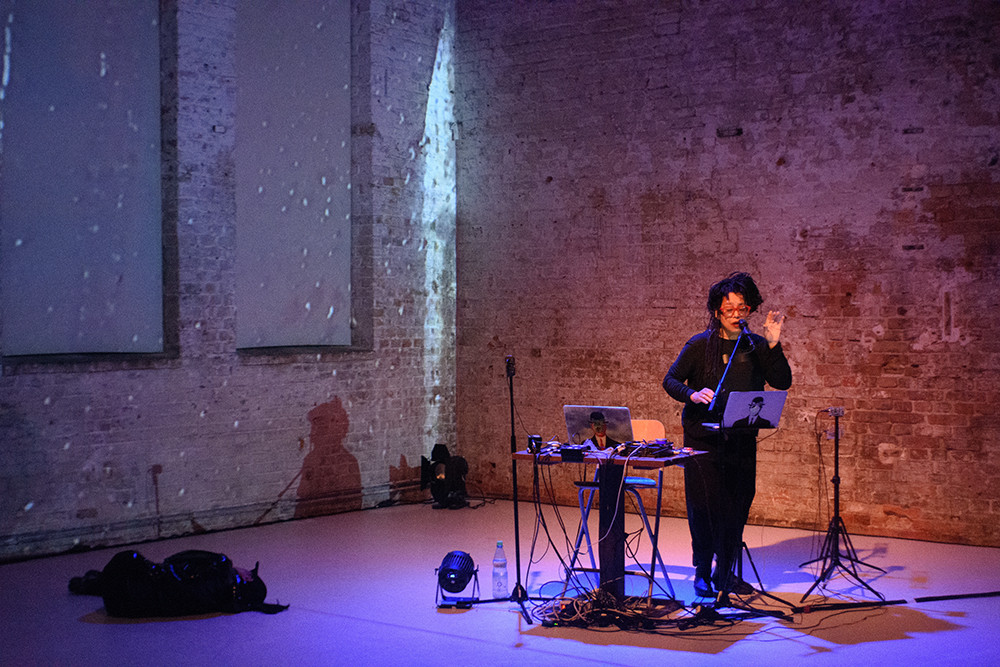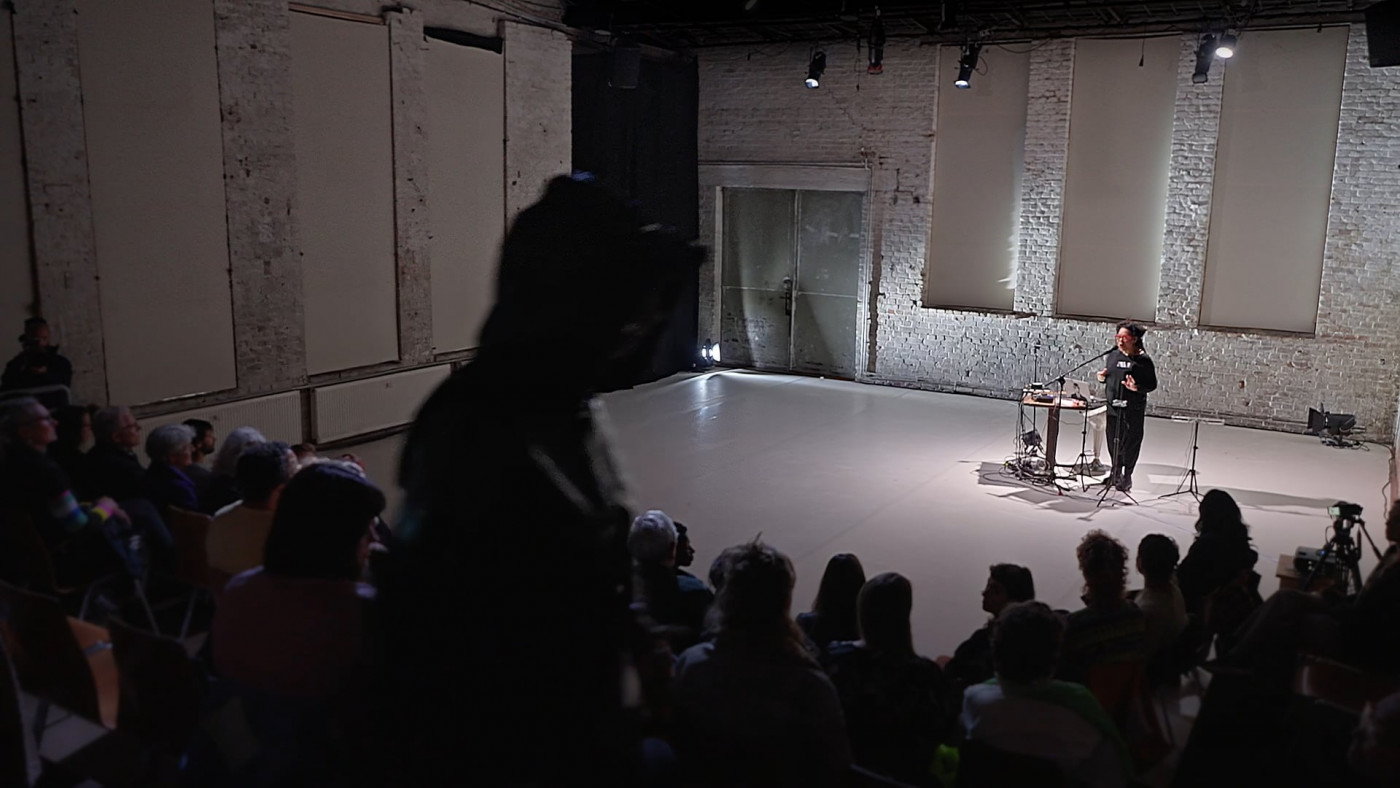
Entangled presences: a conversation with Christine Bonansea Saulut
On the occasion of Christine Bonansea Saulut’s recent piece Intricacy, the conversation explores the collaborative process behind the piece, where choreography and sound intersect. It reflects on the shifting nature of time and space on stage, and how presence, responsiveness, and digital tools converge in a practice attuned to the complexities — the intricacies — of contemporary performance.
What was the starting point for Intricacy?
Intricacy is a dialogue between two artists — myself and composer Pamela Z. We first met 14 years ago in California through a shared interest in improvisation and experimentation. Over time, our collaboration developed naturally, rooted in mutual respect and an intuitive creative language.
The piece began as a spontaneous sketch for a festival in San Francisco in January 2019 — created in just a few hours. When Pamela later came to Berlin, we revisited and expanded it for DOCK ART, building on that early foundation.
Conceptually, the work explores space, time and connection, drawing inspiration from quantum entanglement — the phenomenon whereby two elements remain linked across distance and influence one another in seemingly intuitive and intelligent ways.
Could you share a bit more about your collaboration with Pamela Z. and the entanglement of sound and movement, composition and choreography?
Pamela has been developing her own artistic practice for over 30 years. She has created a unique technical language using sensors and accelerometers — integrating movement, gesture, and voice through custom-designed controllers. Her work is both sophisticated and seamless; the technology is present but not overt, allowing her operatic voice and the subtlety of her compositions to come through in a very refined way.
I’ve worked extensively with experimental musicians over the years — from electronic and noise artists to classical musicians who incorporate extended techniques and unconventional sounds. This kind of sound work resonates with me physically. Because of its density, frequency, and weight, I don’t just hear it — I feel it. It becomes something I can embody. It shapes the space and gives me something to move with, to respond to.
In Intricacy, a profound dialogue emerges between two distinct artistic presences—my physical movement vocabulary and Pamela's sonic world—creating not a uniform fusion but rather a layered conversation akin to collage. What makes this collaboration exceptional is how we maintain our individual artistic identities while establishing a relationship of mutual accompaniment and attentive listening. The performance thrives on connection without demanding synchronization, as we navigate shared space with both intimacy and independence.
In Intricacy, you explore notions related to quantum entanglement. How does this concept translate into choreographic or performative language for you?
Talking about quantum entanglement in physical terms is abstract — it deals with particles we can’t see, yet its principles are scientifically proven. Even if we don’t perceive them in daily life, we sense many invisible forces. Without being mystical, I believe in energetic fields as something very real and physical.
As dancers, our bodies are in constant dialogue with these unseen dynamics — with time and space. The body awareness always intensifies on stage.
Here Quantum physics, particularly the concept of entanglement, serves as both metaphor and inspiration for this work. It evokes a profound interconnectedness where elements exist simultaneously and in relation to one another. Rather than seeking perfect harmony, I explore how diverse elements unfold in tandem, linked through invisible yet powerful systems of relationship and response.
In my collaboration with Pamela, the choreography evolved from a shared structural foundation—rooted in distinctive states, significant actions, and compositional elements like accumulation, interruption, and repetition. She uses looping sounds, cyclical video sequences, and recurring spatial configurations—such as the video square in the piece that suggests confinement or movement patterns evoking labyrinthine navigation—to create sensations of cyclical time, disorientation, and temporal resonance.
Through the prism of metaphysical perspectives—drawing from literature, philosophy, and physics—I explore symbolic themes of the human condition on stage.
Quantum theory suggests events can be correlated across time as well as space. In Intricacy, you construct moments where past and future actions feel fused — where movement seems to echo or anticipate itself outside linear time. How do you choreograph that sense of temporal blur?
To put it simply: it’s about being completely in the present. The present is like a spark — instantly becoming the past, already touching the future. In that state of heightened presence, time can blur. It’s not a theoretical concept — it’s a physical, lived experience.
I often work with improvisational structures that demand extreme sensitivity. That alertness creates real-time intensity — more powerful than any constructed or virtual experience. On stage, this presence is amplified: you're carrying memory while being pulled toward what’s next. Fully inhabiting that tension opens a space where past and future overlap.
In Intricacy, that blur emerges organically. We built a responsive compositional system — not fixed, but structured through repetition, loops, and interruption. These elements create echoes, anticipations, and shifts. The choreography arises from connection — with the body, sound, space — and through that, time begins to feel fluid, less linear, more entangled.
Your other works, such as Yūgen, Artificial Archeology, and GAMER, showcase a profound integration of technology. How do these technological elements influence your choreographic process? How does it shape the narratives or themes you explore?
For me, dramaturgy often begins with space — not as a backdrop, but as an active force. Even in traditional venues, I reimagine how bodies relate to their environment. This spatial focus led me naturally to multimedia tools: light, sound, and sensory design became structural elements in my work.
Over time, this evolved into working with more complex technologies: visual art, sound design, and eventually digital systems. I’ve collaborated with musicians, visual artists, and programmers — constantly negotiating how all these mediums can speak together. As a choreographer, performer, and artistic director, I see myself as a mediator among these forms — someone who gives direction but also listens to how the tools merge to create a unique aesthetic together.
In GAMER, for example, I worked with a robotic programer and designer named So Kanno. His 60 robots named “Lasermice” reminded me of video game characters. Therefore I choreographed a piece that integrated his initial robotic work with a dramaturgy reflecting the temporality of a video game design.
Later, I began exploring motion capture, especially in Yūgen. This was both exciting and limiting. While motion capture allows for a new kind of embodiment, I found it also restricts physical expression — it compresses the nuance of movement quality, relationship to gravity and body awareness.
I’m currently developing a project involving an AI camera tracking system that will enable movement quality and embodiment to be analysed in real time. The aim is to achieve real-time responsiveness that is more intuitive and less invasive for the performer.
I consider my integration of technology in the performing art scene as a political statement: an exploration of how we can consciously embody, challenge, and reshape our relationship with technology. It asserts the importance of human presence in an increasingly system-dominated world, emphasising the value of tactile experience, subtle expression and creative autonomy. My integration of technology transcends trendy innovation—it fundamentally questions our position as embodied creators within a rapidly transforming society, seeking a meaningful balance between human essence and technological advancement.
How has your choreographic approach evolved over time? Do you remember particular influences or turning points?
My choreographic path began with a collaboration with composers in San Francisco — that moment sparked my desire to embody sound through movement and space. Sound remains central to my process: it defines the space and creates momentum, which then informs the body's presence within it.
Over time, my aesthetic evolved through a mix of influences: pedagogues like Sara Shelton Mann, whose somatic and transformative practice deeply shaped how I think about space and attention; minimal and sharp visual styles; and philosophical or literary references, like existentialism, phenomenology, and maybe some structuralism which inform my conceptual approach.
My work is experimental and exploratory, based on research and contemporary tools and methods of expression. Although it often looks quite abstract, it reflects essential metaphysical questions.
Berlin, 27/05/2025

By playing this video, you accept Vimeo´s privacy policy. Read more in our privacy policy and at https://vimeo.com/privacy.
